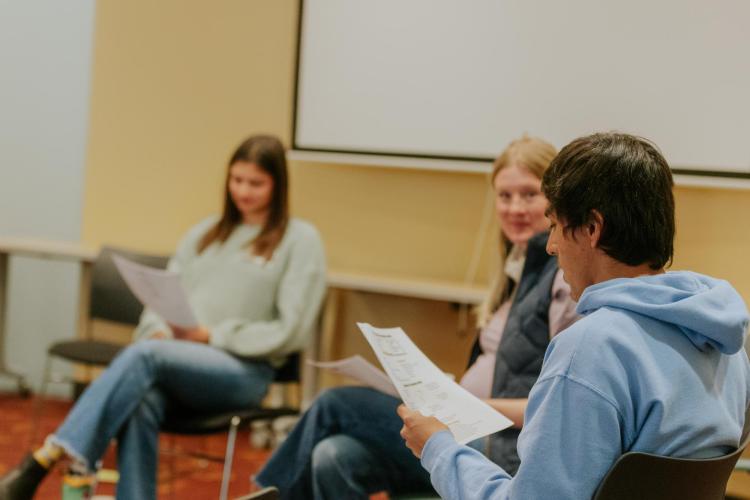5 tips for managing conflict with students

The ideal classroom, lab or lecture fosters thoughtful discussions between you and your students. These collaborative conversations and debates empower students to develop and grow their ideas and perspectives.
It is important to remember that conflict is normal, and there are effective ways to navigate difficult conversations with your students.
Here are some strategies instructors can use to support students and promote conflict resolution.
Proactively discuss classroom expectations
Conflict with students may take various forms. Some disagreements may disrupt the whole class, while others might be a direct conflict between you and a student.
The issue could include classroom interruptions or behavioral concerns. Or a student may disagree with a grade, late assignment, missed exam or the use of technology that is not allowed or interferes with the class. Most students are not intentionally trying to cause a problem. Instead, the student may be feeling confused, stressed or unsupported.
Instructors and professors can help lessen these concerns by having proactive discussions around course expectations and classroom behavior, including:
- Listing expectations in your course syllabus.
- Discussing the expectations in class at the beginning of the semester.
- Reminding students of the expectations throughout the semester when teaching and during office hours.
Communicating expected student behavior can help mitigate conflict before it starts and foster an environment for healthy conversations.
While faculty should work to resolve disagreements between themselves and students, they do not need to be responsible for mediating conflict between students. If students in your course have a disagreement that impacts the class, faculty are encouraged to listen to their concerns, recommend Student Conduct & Conflict Resolution resources and refer the students to mediation or conflict coaching.
Email Conflict Resolution to refer students or learn more.
Listen to students for understanding
Strengthening your relationships with students can help prevent conflict. If students feel comfortable sharing their concerns with you, faculty and staff should take those opportunities to listen.
Employ these tips for productive conversations:
- Enter conversations with an open mind.
- Recognize that there may be something going on in the student’s life outside of academics that is affecting them.
- Express empathy for how a student’s life experiences can impact their behavior. The student’s reaction may differ from your interpretation of the conflict.
- Acknowledge and validate the student's feelings by listening fully without judgment.
- Help the student feel heard and valued by asking questions to clarify what they are trying to say.
When conflict arises, give your students space to share their points of view. When you initiate a dialogue with a student, do so privately, like during office hours or other scheduled meetings.
Reflect on your impact
Professors and instructors are in a position of authority when dealing with students. Be aware of the power dynamic and take responsibility for initiating the conflict resolution process.
Due to this power imbalance, there may be times when your intentions do not align with your impact. Take steps to evaluate your actions and rectify the situation.
- Consider the impact of your words and actions on students.
- Ask yourself if your message or delivery was disproportionately demanding or hurtful.
- Take responsibility for the harm caused and discuss actions you will take in the future to ensure it does not happen again.
- Ask yourself if you are the best person to discuss the situation with the student. Would other faculty, staff or students be better suited to respond? Sometimes, asking for help to initiate a difficult conversation can be beneficial.
We encourage faculty and staff to take accountability for adverse impacts. You can serve as a role model by showing students a positive example of taking ownership of your impact and working to repair harm.
Find common ground and follow up
When looking for a resolution, get the student’s perspective. Ask if they have ideas for a solution. Faculty and instructors can reflect on and discuss the following:
- What outcomes do you and the student each hope come from the resolution?
- How can you and the student work together to meet each other’s needs?
- What steps can you and the student take to achieve these goals?
After coming to a resolution, follow up with the student. These difficult conversations may hold a greater weight to them than they do for you. Check back in and recommend resources in Student Conduct & Conflict Resolution (SCCR) if the student could benefit from additional support.
Take advantage of available resources and training
Any faculty or staff member can contact SCCR for conflict resolution support. You can submit an SCCR incident report if the conflict with a student escalates or email Conflict Resolution to discuss strategies, schedule training and access resources such as:
- Conflict coaching for individuals.
- Mediation services for two or more participants.
- Circle dialogues for small groups.
- Conflict resolution skills training for groups of any size.
You can request conflict resolution training and workshops to be facilitated by SCCR staff.
If you are concerned about a student, refer them to Student Support & Case Management. If there is an immediate safety concern, contact the CU Police Department.

